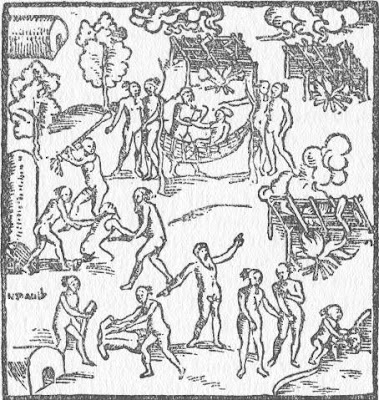Πέμπτη 13 Μαΐου 2010
Hans Staden's and Theodore de Bry's tribal canibalism illustrations
O Hans Staden (1525-1579) ήταν Γερμανός στρατιώτης και ναυτικός που ταξίδεψε με Πορτογαλικές αποστολές στη Νότια Αμερική. Στο δεύτερο ταξίδι του, κατά τη διάρκεια κυνηγιού, συνελήφθη από πολεμιστές της φυλής των Tupinambá και κρατήθηκε αρκετό καιρό αιχμάλωτος. Ισχυρίστηκε ότι τα μέλη της ήταν ανθρωποφάγα, που έτρωγαν σε τελετουργικά γεύματα τους αιχμαλώτους τους. Ηταν και αυτός υποψήφιος για να γίνει γεύμα, αλλά έκανε μια εξυπηρέτηση στον αρχηγό της φυλής θεραπεύοντάς τον από μια αρρώστια και έτσι την γλύτωσε. Λέγεται ότι του έδωσαν να δοκιμάσει μια σούπα, από ένα καζάνι που στον πάτο είχε δυο μικρά κρανία τα οποία ήταν από παιδιά της χορωδίας του! Αφού απέτυχαν οι διαπραγματεύσεις των Πορτογάλων με τους Tupinambá για απελευθέρωσή του, τελικά δραπετεύει και το 1555 επιστρέφει στην Ευρώπη όπου γράφει και εκδίδει σε βιβλίο τις εμπειρίες του το 1557. Το δε εικονογραφημένο κεφάλαιο με τις γλαφυρές και λεπτομερείς περιγραφές των κανιβαλικών συνηθειών των Tupinambá αποτέλεσε και τον κυριότερο λόγο της τεράστιας επιτυχίας αυτού του βιβλίου. Αν και πολλοί αμφισβήτησαν την αλήθεια των περιγραφών του, ακόμα κάποιοι το χρησιμοποιούν ως έγκυρη και αξιόπιστη εθνογραφική αναφορά.
Αν και αυτό είναι το πιο περιγραφικό βιβλίο για τον κανιβαλισμό, αυτό που έχει τις πιο σοκαριστικές εικόνες είναι το βιβλίο του Theodore de Bry (1528–1598) που αναφέρεται στις επισκέψεις διαφόρων αποίκων στην νεοανακαλυφθείσα Αμερική.
Hans Staden (1525-1579) was a German soldier and mariner who voyaged to South America. On one voyage, he was captured by the Tupinambá people of Brazil whom he claimed practiced cannibalism. He wrote a widely read book describing his experiences.
During his second trip to South America, while engaged in a hunting expedition, he was captured by a party belonging to the Tupinambá people of Brazil. They carried him to their village where he claimed he was to be devoured at the next festivity. He allegedly won the friendship of a powerful chief, whom he cured of a disease, and his life was spared. The Portuguese tried several times to negotiate for Staden's ransom, but the Indians declined all overtures. At last he made his escape on a French ship, and on 22 February 1555, arrived at Honfleur, in Normandy, and from there went immediately to his native city.
After his return to Europe, he published an account of his captivity, entitled Warhaftige Historia und beschreibung eyner Landtschafft der Wilden Nacketen, Grimmigen Menschfresser-Leuthen in der Newenwelt America gelegen (True Story and Description of a Country of Wild, Naked, Grim, Man-eating People in the New World, America) (1557). The book became an international bestseller.
The Warhaftige Historia provided detailed descriptions of Tupinambá life and customs, illustrated by woodcuts. However, the aspect of the book that received the most attention, from the time of publication up to the present, was cannibalism. Staden claimed that the Tupinambá were cannibals, gave vivid eyewitness accounts of the killing, preparing and eating of war captives. According to one anecdote, the Indians at one point gave him a delicious soup; after finishing his dinner, he found in the bottom of the cauldron some small skulls, which he later found out to be those of the children in his choir.
Some scholars have challenged the book's reliability, arguing that Staden invented its sensational accounts of cannibalism. Others defend the book as an important and reliable ethnohistorical source. (wikipedia)
But the most creepy illustrations of tribal cannibalism in Latin America when discovered, was those by Theodore de Bry (1528–1598) in his book about the colonisation of America by various colonists) .
Ετικέτες
book illustrations,
customs,
Hans Staden,
Theodore de Bry
Εγγραφή σε:
Σχόλια ανάρτησης (Atom)























.jpg)




Προσέξτε κάποιες ομοιότητες μεταξύ των εικόνων του Staden και του De Brys που είναι μεταγενέστερές του. Ο De Brys δεν ταξίδεψε ποτέ, όλα τα ζωγράφισε ακούγοντας ή διαβάζοντας περιγραφές, και προφανως είχε σαν βάση το βιβλίο και τις εικόνες του Staden
ΑπάντησηΔιαγραφή